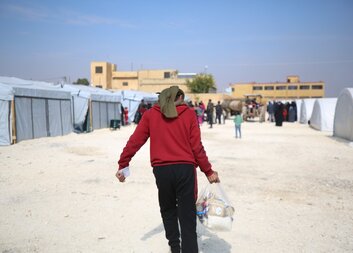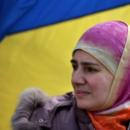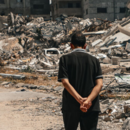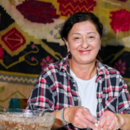It has been 14 years since the war in Syria began — a conflict that became one of the biggest humanitarian crises of our time. Although the recent fall of the Bashar Assad regime has brought hope for a better future for many Syrians, it has also introduced new challenges. Why was Syria at war for so long? What are the implications of Assad's fall? And what else should you know about the war in Syria and its aftermath?
1. How long has Syria been at war and how did the war start?
The civil war in Syria began on 15 March 2011 with demonstrations in response to the events of the so-called Arab Spring. Even before the outbreak of the conflict, many Syrians were complaining about high unemployment, corruption and lack of freedom under the rule of President Bashar Assad. Unrest spread across the country, violence escalated rapidly and Syria soon descended into civil war.
Hundreds of rebel groups have emerged, and extremist jihadist organisations such as the self-proclaimed Islamic State and al-Qaeda have joined the conflict. Russia has joined the war on the side of Syrian President Bashar Assad. Other foreign powers have also become involved in the conflict, notably Turkey, Iran, the United States and, with air strikes, Israel.
Although Bashar al-Assad's government previously maintained control over Syria’s largest cities, the country’s power dynamics have dramatically shifted following his overthrow in December 2024.
Hay’at Tahrir al-Sham (HTS), the group that led the offensive resulting in Assad's fall, now appears to control the largest territory in the country. However, Syria remains fragmented, with control divided among various armed groups. HTS remains a dominant force in Northwest Syria, one of the areas most affected by both the war and the 2023 earthquake.
The northeast of the country has long been under the control of the Syrian Democratic Forces (SDF), led by the Kurds. However, in March a landmark agreement was reached between the SDF and the Syrian government to integrate SDF military and civilian forces and institutions into the central government in Damascus. This move marks the end of fighting in the north-east of the country and the return of the region to the administration of the central government. The agreement should also guarantee the rights and status of the Kurds within the Syrian state.
Other rebel and jihadist groups continue to operate in pockets across the country, while Israeli forces have established a military presence in southern Syria.
2. The fall of Bashar al-Assad and its implications
The Syrian regime of President Bashar Assad collapsed after 24 years on the night of Sunday 8th of December. The dictator was toppled by a rebel offensive in 11 days. According to Russian media, Assad and his family are now in Moscow. Although the removal of Assad from power brought hope for many Syrians, it has also created significant uncertainty. Opposition groups and local factions are competing for control, and the political future of Syria remains unclear. International actors, including Russia and Iran, are adjusting their strategies, while regional powers such as Turkey and Israel are expanding their influence.
Additionally, Israel has taken advantage of Assad’s fall to expand into the demilitarized buffer zone between the Israeli-occupied Golan Heights and southern Syria, breaching a United Nations agreement brokered in 1974. The Israeli military presence in Syria, previously limited to airstrikes and targeted operations, is now becoming stronger in the region.
Syria remains in a fragile state following the overthrow of President Bashar al-Assad in December 2024. The latest violence erupted in March in Syria's coastal region, where an operation against supporters of the former regime took place. Clashes quickly degenerated into a massacre of civilians, mostly Alawites. This is an area where Bashar al-Assad enjoyed strong support and where the Alawites, a minority Shi'ite Islamic sect to which Assad and his family belong, live in particular. Over a few days, more than a thousand people have been killed, while armed groups have invaded villages, looting and killing. The violence has contributed to another wave of displacement and deepened the humanitarian crisis.
In northwest Syria, displacement continues with sporadic violence, while economic instability and the ongoing humanitarian crisis further challenge the region's recovery.
3. What is the current situation in Syria?
After 14 years since the beginning of the war, the situation in Syria is desperate. Basic services and critical infrastructure are on the verge of collapse. Even after Assad’s fall, problems remain with widespread and frequent power cuts even in large cities such as Damascus and Aleppo. The health sector has also been significantly affected by the war. Up to a quarter of hospitals and a third of all health facilities in the country are dysfunctional.
Syria's economy, crippled by more than a decade of war, complicates daily life in Syria. Basic necessities are increasingly unaffordable, prices of essential commodities have almost doubled, inflation is rising and the currency is depreciating. More and more people are falling into poverty and are dependent on humanitarian aid.
The recent ceasefires in Gaza and Lebanon have brought a period of relative calm to the region, though the situation remains uncertain. The ceasefire in Gaza has temporarily paused hostilities, but its future is unknown as tensions persist. In Lebanon, the ceasefire has reduced cross-border clashes, creating some stability for now. These developments have also influenced the situation in Syria, where shifting regional dynamics continue to shape the conflict. These developments have reduced the influx of refugees into Syria, easing the burden on already strained resources. However, the situation remains fragile, and continued international support is essential to address the ongoing humanitarian needs within Syria.
Humanitarian organisations and local authorities are providing emergency healthcare, temporary shelter, and protection services. However, the need for more sustainable shelter, food supplies, psychosocial support, and medical assistance remains critical.
In recent years, Syria has also faced drought, which is set to worsen in the face of climate change.
Despite this, the people of Syria are trying to carry on with their normal lives as far as the situation allows. Caritas Czech Republic is supporting them to do so.
4. How many people in Syria need humanitarian aid?
It is estimated that 16.7 million people out of a total population of 23 million will need humanitarian aid in Syria this year. This is the largest number of people ever since the war began and 1.3 million more than last year.
Northwest Syria remains one of the areas with the greatest humanitarian need, with over 4.2 million people reliant on aid. The economic crisis continues to cripple public services, with regions like Homs and Hama receiving only limited electricity—often less than an hour every eight hours. Shortages of construction materials and cash flow have further slowed reconstruction efforts.
The health sector is particularly strained, especially in northwest Syria, where over 100 health facilities have run out of funding. The halt in USAID funding has also forced several NGOs to suspend WASH (water, sanitation, and hygiene) services, affecting at least 650,000 displaced people.
Meanwhile, food insecurity remains widespread, with over 3 million Syrians severely food insecure and an additional 12.4 million at risk. Households headed by single mothers, the elderly, people with disabilities and children are particularly vulnerable to the crisis - up to 3.7 million children in Syria are out of school, more than half of the children at school age.
5. How many Syrian refugees and internally displaced people are there and where do they live?
More than half of Syria's pre-war population has fled their homes. It is estimated that 7.4 million have fled to other places in the country. This is the second largest number of internally displaced people worldwide. The situation is worst in the north-west of the country, where large numbers of internally displaced people have fled. They have often been displaced for several times and have difficulty reintegrating back into society.
A further 6.8 million Syrians have made their way to safety beyond Syria's borders, mostly to neighbouring countries such as Lebanon, Jordan and Turkey, which host 5.2 million of all Syrian refugees. Despite the challenges, a growing number of Syrians have begun returning home. Since December 2024, nearly 1.2 million people have returned to their areas of origin in Syria, including over 885,000 internally displaced persons, and over 290,000 Syrians from other countries. A recent UNHCR survey found that almost 30% of Syrian refugees in neighbouring countries intend to return within the next year.
However, conditions for returnees remain difficult. Many arrive to find their homes destroyed or uninhabitable, particularly in heavily impacted areas like Aleppo, Homs, and Idlib.
6. How has the devastating earthquake in February 2023 affected the crisis in Syria?
The devastating 7.8-magnitude earthquake that struck Turkey and Syria on 6 February 2023 further deepened Syria’s humanitarian crisis. In north-west Syria—where 4 million people were already in need of aid—the earthquake displaced thousands more, worsening already dire living conditions. Over 8.8 million people in Syria were affected, including 3.7 million children.
Though two years have passed, the earthquake’s impact is still felt today. Many affected areas remain in ruins, with reconstruction efforts slow due to ongoing instability, economic collapse, and funding shortfalls.
7. How is Caritas Czech Republic helping in Syria?
Caritas Czech Republic has been helping in Syria since 2013. Initially, we focused on providing immediate humanitarian aid. We also supported the health sector and funded the operation of a mobile clinic operating in the northwest of the country and a clinic in Aleppo. In Syria, as part of the country's development, we have also supported young Syrians to set up their own businesses to earn a living in a country where job opportunities are scarce.
In the north-west, we are supporting civil society and training local NGOs to work in the humanitarian and development sectors so that they can contribute to the reconstruction of the country and improve the lives of people in the region. Working with our partner organisation Violet, we have been able to create a network of NGO volunteers in Syria. Moreover, this cooperation proved its worth in the first hours after the devastating earthquake. Thanks to the established cooperation with a number of volunteers and the knowledge that the Syrian organisations gained from the Caritas Czech Republic, their members and volunteers were able to immediately get involved in helping the people affected by the earthquake. As a result, aid reached many more people in a much shorter time.
We have distributed food and hygiene packages to people affected by the earthquake, provided shelter in tents and installed latrines with water supplies to prevent the spread of epidemics. We also provided much needed psychological assistance and psychosocial support to help the affected people cope with the trauma caused by the earthquake.
Displaced people in Syria now live in harsh living conditions, suffer from a lack of clean drinking water and lack access to decent sanitation due to bombing and inadequate maintenance of water sources. For this reason, we are improving access to drinking water for more than 6,500 people and providing them better sanitation.
Violence against women is also a major problem in Syria. The conditions created by the crisis are not safe for local women and they are often subjected to sexual or domestic violence and forced marriage. That is why we spread awareness of this issue and organise presentations on the topic of violence against women and how to protect against it.















